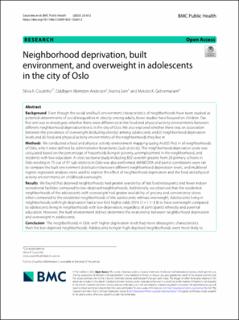| dc.contributor.author | Andersen, Oddbjørn Klomsten | |
| dc.contributor.author | Lien, Nanna | |
| dc.contributor.author | Coutinho, Sílvia R. | |
| dc.contributor.author | Gebremariam, Mekdes K. | |
| dc.date.accessioned | 2023-10-12T15:33:16Z | |
| dc.date.available | 2023-10-12T15:33:16Z | |
| dc.date.created | 2023-05-31T13:38:22Z | |
| dc.date.issued | 2023 | |
| dc.identifier.citation | BMC Public Health. 2023, 23(2023), Artikkel 812. | en_US |
| dc.identifier.issn | 1471-2458 | |
| dc.identifier.uri | https://hdl.handle.net/11250/3096193 | |
| dc.description | This article is licensed under a Creative Commons Attribution 4.0 International License, which permits use, sharing, adaptation, distribution and reproduction in any medium or format, as long as you give appropriate credit to the original author(s) and the source, provide a link to the Creative Commons licence, and indicate if changes were made. The images or other third party material in this article are included in the article's Creative Commons licence, unless indicated otherwise in a credit line to the material. If material is not included in the article's Creative Commons licence and your intended use is not permitted by statutory regulation or exceeds the permitted use, you will need to obtain permission directly from the copyright holder. | en_US |
| dc.description.abstract | Background: Even though the social and built environment characteristics of neighborhoods have been studied as potential determinants of social inequalities in obesity among adults, fewer studies have focused on children. Our first aim was to investigate whether there were differences in the food and physical activity environments between different neighborhood deprivation levels in the city of Oslo. We also explored whether there was an association between the prevalence of overweight (including obesity) among adolescents and (i) neighborhood deprivation levels and (ii) food and physical activity environments of the neighborhoods they live in.
Methods: We conducted a food and physical activity environment mapping (using ArcGIS Pro) in all neighborhoods of Oslo, which were defined by administrative boundaries (sub-districts). The neighborhood deprivation score was calculated based on the percentage of households living in poverty, unemployment in the neighborhood, and residents with low education. A cross-sectional study including 802 seventh graders from 28 primary schools in Oslo residing in 75 out of 97 sub-districts in Oslo was also performed. MANCOVA and partial correlations were ran to compare the built environment distribution between different neighborhood deprivation levels, and multilevel logistic regression analyses were used to explore the effect of neighborhood deprivation and the food and physical activity environments on childhood overweight.
Results: We found that deprived neighborhoods had greater availability of fast food restaurants and fewer indoor recreational facilities compared to low-deprived neighborhoods. Additionally, we observed that the residential neighborhoods of the adolescents with overweight had greater availability of grocery and convenience stores when compared to the residential neighborhoods of the adolescents without overweight. Adolescents living in neighborhoods with high deprivation had a two-fold higher odds (95% CI = 1.1–3.8) to have overweight compared to adolescents living in neighborhoods with low deprivation, regardless of participants’ ethnicity and parental education. However, the built environment did not determine the relationship between neighborhood deprivation and overweight in adolescents.
Conclusion: The neighborhoods in Oslo with higher deprivation levels had more obesogenic characteristics than the low-deprived neighborhoods. Adolescents living in high-deprived neighborhoods were more likely to have overweight than their counterparts from low-deprived neighborhoods. Thus, preventive measures targeting adolescents from high-deprived neighborhoods should be put in place in order to reduce incidence of overweight. | en_US |
| dc.language.iso | eng | en_US |
| dc.subject | childhood overweight | en_US |
| dc.subject | food environment | en_US |
| dc.subject | neighborhood deprivation | en_US |
| dc.subject | physical activity environment | en_US |
| dc.title | Neighborhood deprivation, built environment, and overweight in adolescents in the city of Oslo | en_US |
| dc.type | Peer reviewed | en_US |
| dc.type | Journal article | en_US |
| dc.description.version | publishedVersion | en_US |
| dc.rights.holder | © The Author(s) 2023 | en_US |
| dc.source.pagenumber | 14 | en_US |
| dc.source.volume | 23 | en_US |
| dc.source.journal | BMC Public Health | en_US |
| dc.identifier.doi | 10.1186/s12889-023-15261-2 | |
| dc.identifier.cristin | 2150459 | |
| dc.description.localcode | Institutt for idrettsmedisinske fag / Department of Sports Medicine | en_US |
| dc.source.articlenumber | 812 | en_US |
| cristin.ispublished | true | |
| cristin.fulltext | original | |
| cristin.qualitycode | 1 | |
